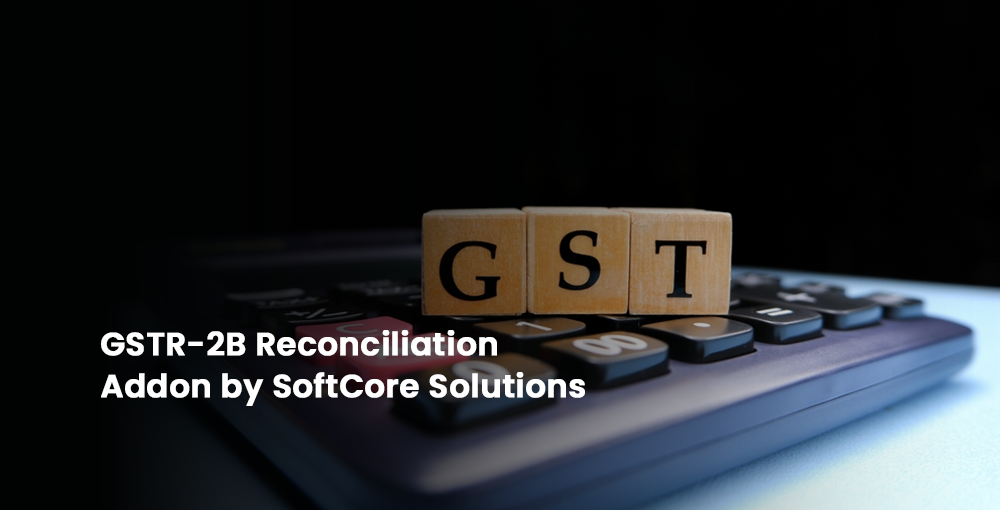
GSTR-2B Reconciliation Addon by SoftCore Solutions
Claiming Input Tax Credit (ITC) accurately in the country’s Goods and Services Tax (GST) can be complicated for businesses including navigating through India’s complex GST. The introduction of GSTR-2B in SAP Business One ERP is a game changer that aims to make these processes easy. As an auto-drafted ITC statement, GSTR-2B addon provides businesses with a reliable, static document each month, offering a clear snapshot of eligible and ineligible credits. This not only aids in precise ITC claims but also ensures compliance with GST regulations, thereby minimizing the risk of errors and financial penalties. In this blog, we will explore the challenges of GSTR-2B, key features, effective use, and best practices to maximize its benefits for your business.
Challenges faced by GSTR2B:
- Manual Reconciliation
- Maintenance of Historical Unreconciled Records
- Aligning Mismatches
- Duplicating work leading to inaccurate finances and low productivity
- Missing invoices between book records and GSTR2B document and vice versa
- Long procedures cause manual errors
- Multiple datasets include SAP section wise data
GSTR-2B is an invoice statement introduced on the GST portal for regular taxpayers. It lists out eligible and ineligible Input Tax Credit (ITC) for each month, it does not change even if suppliers update their details later. Thus, once you retrieve GSTR-2B for a given month, its contents will remain as they are.
What is GSTR-2B Data Reconciliation?
GSTR-2B data reconciliation involves checking the details of Input Tax Credit (ITC) mentioned in the GSTR-2B statement correspond with those shown in an organization’s own purchase records to maintain accuracy and uniformity. With this reconciliation process, businesses can verify that the ITC they claim in their GST returns tallies with what their suppliers have reported.
Let’s understand how SAP Business One’s addon helps in easing the challenges of GSTR2B.
Key features of GSTR2B addon:
- It automatically identifies SAP data that does not match with the unreconciled GSTR2B record
- Tax benefits through input tax credit matching with amended regulations and sections.
- Show RCM Transactions generated from within SAP, and which are also available on GSTR2B
- Identification of available GSTR2B data compared to SAP record
- Invoices tracking and viewing reconciled summary status
- Supports multiple users authorized to access different GSTINs
- It is easy to communicate via email with suppliers.
- Keeping track of reconciled statuses at document level.
- Updated software will be made available as per changed compliance.
- Displaying Verified Transactions based on comparison of GSTR2B and Purchase Register (PR) on a Year-to-Date (YTD) Basis.
What does Auto Reconciliation mean?
Auto reconciliation is the automated process of linking and ensuring that data matches up correctly. It automatically reconciles Input Tax Credit (ITC) details from the GSTR-2B statement against the purchase records of a business if all the criteria are met.
The auto reconciliation comprises 3 categories:
- Exact Match: Here, in relation to SAP system and GSTR2B record, all such information including GSTIN, INVOICE NUMBERS, TAX AMOUNTS AND TAXABLE AMOUNTS are exactly similar.
- Likely Match: The remaining criteria like GSTIN, INVOICE DATE, TAX AMOUNT, AND TAXABLE AMOUNT must be alike between SAP data and GSTR2B data to qualify for reconciliation. However, the invoice number differs slightly.
- Matched Invoice Date: If all other details are same including TAX AMOUNT, INVOICE DATE and TAXABLE AMOUNT but only invoice number seems different between SAP system and GSTR2B record then it is considered as match.
What is Manual Reconciliation?
Manual reconciliation involves the physical comparison of data from different sources. Checking the GSTR-2B statement with a business’s purchase records is done manually.
These are features that come with Manual Reconciliation:
- Suppliers’ names can be searched, or GST numbers can be used for searching
- Tax Reco
- SAP Flags
- Email functionality
To get an in-detail information about how SAP B1’s GST addon makes things easy for an organization, book a free demo with SoftCore Solutions, the best and trusted ERP implementation partner in India.
Best Practices to maximize benefits in the organization:
- Perform reconciliations monthly for quick identification and resolution of mismatches.
- Ensure all invoices and debit notes pertaining to purchases are correctly captured into the accounting system like GSTIN, invoice number and tax amount.
- Add-ons such as invoice tracking, viewing reconciled status summaries, email functionalities or managing RCM transactions can be utilized by you.
- To cover all departments, manage multiple GSTINs.
- Analyze reconciliation reports prepared by add-on to detect any trends or common problems.
GSTR-2B addon, in conclusion, appears to be critical that helps to reduce the complexities of Goods and Service Tax (GST) by providing a way for companies to claim Input Tax Credit (ITC) accurately and at the same time ensuring they comply with legal requirements. Although there remain challenges such as offline reconciliation, software like SAP Business One’s addon has led to increased automation resulting in simplified processes, reduced errors and improved productivity. To exploit these applications and get a grasp of auto versus manual reconciliation subtleties with respect to goods and services tax, organizations should have optimism toward being able to optimize their ITC claims, financial management and ultimately accelerate development.
Contact SoftCore Solutions today.